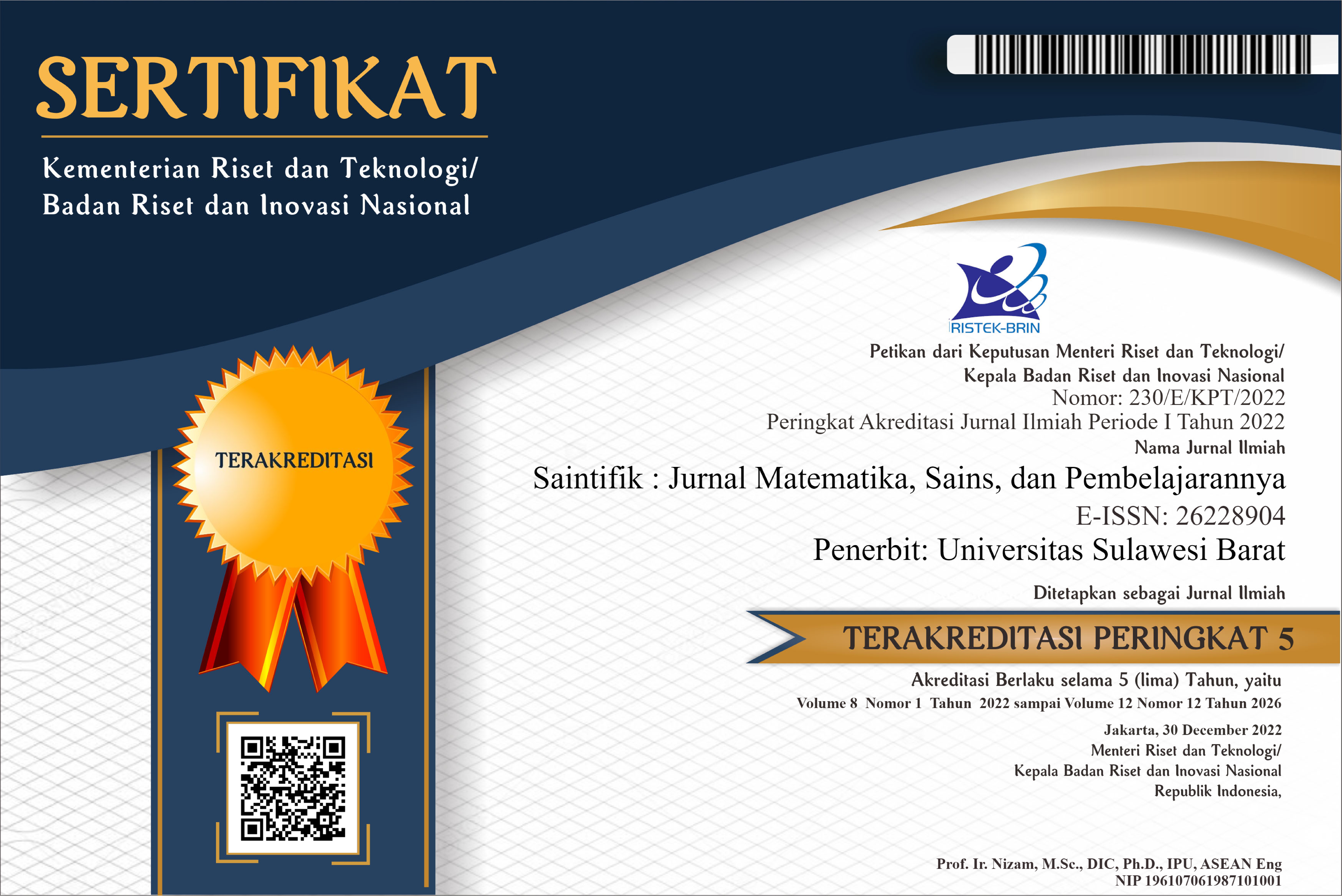Konstruksi Pseudo Berdasarkan Kecenderungan Pengetahuan Prosedural
Abstract
Penelitian kualitatif ini dilakukan pada siswa kelas VIII. Tujuannya adalah mengkaji proses konstruksi pseudo benar dan salah berdasarkan kecenderungan pengetahuan prosedural, dan menetapkan karakteristiknya.Peneliti menemukan bahwa Konstruksi pseudo benar ketika siswa menyelesaikan operasi penjumlahan pecahan bentuk aljabar terjadi ketika siswa memberikan jawaban yang benar dengan prosedur penyelesaian yang benar, tetapi siswa tidak mampu memberikan justifikasi terhadap prosedur yang digunakan.Konstruksi pseudo salah terjadi dalam dua kondisi.Pertama, kondisi ketika siswa memberikan jawaban yang salah dengan prosedur penyelesaian yang salah, karena siswa terdorong untuk menjawab dengan cepat.Kedua, kondisi ketika siswa memberikan jawaban yang salah karena careless error dengan prosedur penyelesaian yang benar, dan siswa mampu memberikan justifikasi terhadap prosedur yang digunakan.
Downloads
References
Dhlamini. 2014. Grade 9 Learners’ Errors and Misconceptions In Addition of Fractions.Mediterranean Journal of Social Sciences.Vol 5, No. 8, ISSN 2039-2117 (online) ISSN 2039-9340 (print). Publishing: MCSER
Elbrink. 2007. Analyzing and Addressing Common Mathematical Errors in Secondary Education. B.S. Undergraduate Mathematics Exchange, Vol. 5, No. 1.
Ganesan & Dindyal. 2014. An Investigation of Students’ Errors in Logarithms. Proceedings of the 37th annual conference of the Mathematics Education Research Group of Australasia. pp. 231–238. Sydney: MERGA.
Godden, dkk. 2013. An Analysis of Errors and Misconceptions inThe 2010 Grade 12 Mathematics Examination: A Focus On Quadratic Equations And Inequalities. Proceedings of the 19th Annual Congress of the Association for Mathematics Education of South Africa.Vol. 1. (pp. 70 – 79). Cape Town: AMESA.
Herna. 2018. Analisis Kesalahan Matematika Siswa dalam Menyelesaikan Soal Operasi Penjumlahan Pecahan Bentuk Aljabar. Jurnal Pendidikan PEPATUDZU. Vol. 13, No. 1,p-ISSN: 2087-3476, e-ISSN: 2541-5700.
Herna, Nusantara, T., Subanji, &Mulyati, S. 2016. The characterization of True Pseudo Construction in Understanding Concept of Limit Function. IOSR Journal of Research & Method in Education (IOSR-JRME). Vol. 6, Issue 5 Ver. III, pp. 77-87, e-ISSN: 2320–7388, p-ISSN: 2320–737X.
Huang & Cheng. 2010. Analyzing Errors Made by Eighth-Grade Students in Solving Geometrical Problems in China. The Mathematics Educator. Vol. 12, No.2, 63-80.
Idris & Narayanan. 2011. Error Patterns in Addition and Subtraction of Fractions among Form Two Students.Journal of Mathematics Education. Vol. 4, No. 2, pp. 35-54.
Kahneman, D. 2002. Maps of Bounded Rationality: A Perspective on Intuitive Judgment and Choice, in Les Prix Nobel, Edited by. T. Frangsmyr, pp. 416-499.
Kiat. 2005. Analysis of Students’ Difficulties in Solving Integration Problems. The Mathematics Educator. Vol. 9, No.1, 39-59.
Leron, U. 2004. Intuitif versus Analytical Thinking: Four Theoretical Frameworks.
Lithner, J. 2000. Mathematical Reasoning in Task Solving. Educational Studies in Mathematics, Vol 41, pp. 165-190.
Maat, dkk. 2010. Analysis of Students’ Error in Learning of Quadratic Equations. International Education Studies.Vol. 3, No. 3.
McGowen, M. & Tall, D. O. 2010.Metaphor or Met-before?The effects of previous experience on the practice and theory of learning mathematics.Journal of MathematicalBehavior 29, 169–179.
Pape, J. Steven. 2004. Middle School Children’s Problem Solving Behavior: A Cognitive Analysis from A Reading Comprehension Perspective.Journal for Research in Mathematics Education, 35(3).
Riccomini. 2005. Identification and Remediation of Systematic Error Patterns In Subtraction. Summer.Volume 28.
Sahdra, B. & Chand, I. 2003.Procedural Knowledge in Molecular Biology, Philosophical Psycology. Vol. 16, No. 4, pp. 477-498.
Saler, G. & Edgington, G.C. 2006. Piaget WebQuest.
Subanji. 2007. Proses Berpikir Penalaran Kovariasional Pseudo dalam Mengkonstruksi Grafik Fungsi Kejadian Dinamika Berkebalikan. Disertasi tidak dipublikasikan, Surabaya: Program Pascasarjana UNESA.
Subanji. 2011. Teori Berpikir Pseudo Penalaran Kovariasional. Malang: Universitas Negeri Malang.
Subanji & Nusantara, T. 2013.Karakterisasi Kesalahan Berpikir Siswa dalam Mengkonstruksi Konsep Matematika.Jurnal Ilmu Pendidikan, 19(2), hal. 129-251.
Vinner, S. 1997. The Pseudo-conceptual and The pseudo-analytical thought Processes in Mathematics Learning. Educational Studies in Mathematics 34, pp. 97-129.
Vinner, S. 2000. Mathematics Education –Procedures, Rituals and Man’s Search for Meaning. Ben Gurion University of the Negev, A regular lecture given at ICME 9, Japan.July 31 - August 6.
White. 2010. Numeracy, Literacy and Newman’s Error Analysis. Journal of Science and Mathematics Education in Southeast Asia. Vol. 33, No. 2, 129-148.
Yusof & Malone. 2002. Mathematical Errors in Fractions: A Case of Bruneian Primary 5 Pupils. University of Technology.
Copyright (c) 2020 Herna

This work is licensed under a Creative Commons Attribution 4.0 International License.
- Free access for all users worldwide
- Authors retain copyright to their work
- Increased visibility and readership
- Rapid publication
- No spatial constraints







